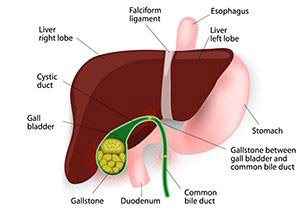The Gallbladder Surgery Specialists at the Tulane University School of Medicine are the region’s leading surgeons for gallbladder surgery (Cholecystectomy).
Although removal of the gallbladder is one of the most commonly performed surgical procedures in the United States it helps to know that your surgeon is a specialist in minimally invasive surgical techniques. Our surgeons are all teaching faculty members of the Department of Surgery at the Tulane University School of Medicine and dedicate part of their practice to instructing other physicians in the most current surgical techniques, including laparoscopy and other minimally-invasive surgical procedures.
The gallbladder is a pear-shaped organ that rests beneath the right side of the liver and is responsible for collecting and concentrating the bile that is produced by the liver as part of the digestive process. The bile travels through the bile ducts (narrow tubes) and empties into the small intestine. Gallstones may block the flow of bile out of the gallbladder, causing it to swell and resulting in sharp abdominal pain, vomiting, indigestion and/or fever. If the gallstones block the bile duct it may also cause jaundice (a yellowing of the skin or the whites of the eyes). Your doctor may recommend gallbladder removal surgery if you have gallstones that are creating problems for you or if your gallbladder is not functioning properly (biliary dyskinesia). Symptoms of gallbladder problems can include:
- Indigestion
- Infection of the gallbladder (cholecysitis)
- Regular nausea and vomiting
- Pain after eating (epigastric pain) usually in the right or upper middle area of your stomach under the ribs
Once gallstones have developed they will not go away on their own. Symptoms can sometimes be reduced with drugs or diet modifications but these are temporary measures; eventually the symptoms will return and may get worse. The safest and most effective method to manage gallstones and other gallbladder problems is the surgical removal of the gallbladder.

The first step in diagnosing gallstones is to make sure that the symptoms are not associated with another disease. If your physician suspects that you have gallstones they will perform an ultrasound examination in order to check your liver, bile ducts and pancreas, as well as scan for a thickening of the gallbladder wall. In some cases an endoscopic ultrasound, x-ray or other tests may be performed as well. If gallstones or other gallbladder related problems are identified you will be referred to a Gallbladder surgeon.
Laparoscopic surgery (a minimally invasive surgery technique) is the most common way of performing gallbladder surgery. Under general anesthesia the surgeon will make 3 or 4 small incisions in your abdomen. The laparoscope, a small, flexible video camera and light, will be inserted into one incision in order to give the surgeon an enhanced view of the internal organs; surgical instruments will then be inserted into the other incisions.;
The surgeon will use the surgical instruments to separate the gallbladder from the other organs and remove it through one of the openings. Your surgeon may also perform a cholangiogram in order to identify stones in the bile duct. The cholangiogram involves injecting dye into the common bile duct and taking an x-ray; this helps the surgeon to identify the branches of the bile duct and any stones that may be present. If a stone(s) is found in the bile duct it can be removed with a special scope.After the gallbladder is removed the small incisions are closed with a stitch or with surgical tape.
Open surgery is sometimes necessary if the stones cannot be removed by using the special scope or if the surgeon cannot remove the gallbladder safely using a laparoscope.Other reasons for performing an open procedure can include:
- Obesity
- Pancreatitis
- Pregnancy
- Liver disease
- Lung disease
- Bleeding disorders
- Previous surgeries in this area of your abdomen
During an open gallbladder procedure the surgeon will make a surgical incision across your abdomen, below your ribs, in order to access the gallbladder. The gallbladder will be separated from the other organs and removed, and the incision closed with stitches. The decision to perform the open procedure is a judgment decision made by your surgeon either before or during the actual operation. If the surgeon has to convert from a laparoscopic procedure to an open procedure during surgery the conversion is always based on patient safety.
